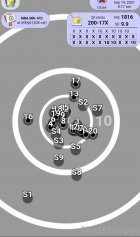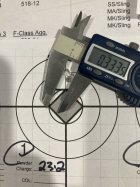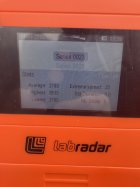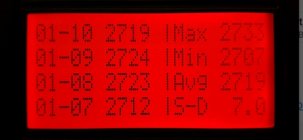Ned Ludd
Silver $$ Contributor
There have been many past discussions here with regard to the typically high ES/SD values of .223 Rem F-TR loads relative to the larger calibers used in F-TR (.308 Win) or F-Open. It is a fairly common malady that most F-TR shooters using .223 Rem in F-TR will experience at one time or another. I have been shooting .223s with 88-95 gr "heavies" in F-TR for a number of years. When I first had the idea of shooting a .223 Rem with 90 VLDs in F-TR, information regarding that specific combination on the internet was quite scarce...a piece here, a little nugget over there, so it was necessary to try and piece it all together to make the most informed choices regarding the rifle build as I could, and basically learn the nuances of reloading for it by trial and error once the build was finished.
Early on, the best combination I found with 90 VLDs was Lapua brass, Fed 205 primers, and H4895 powder. After adding a second dedicated .223 Rem F-TR rifle to the stable and many years of experimentation later, I have still not found a combination that is demonstrably better. Both of my rifle wear 30" Bartlein 5R barrels that have no-turn neck chambers (0.2527" according to the reamer print) with at least 0.169" freebore. Both chambers/reamers I have are based on PTG's 223 Rem ISSF original reamer specs, with the only difference being that one has a little longer freebore.
I generally run the 90s at around 2830-2840 fps in competition loads. The primary downside to these loads is that they are on the warm side and brass life is poor, typically no more than 4 firings, sometimes even less. In my hands, the average/typical ES values for 5-shot strings will range in the ~17 to 25 fps range. I might occasionally observe an ES value slightly lower or higher, i.e. as low as ~10-15 fps or as high as ~30-35 fps, but upper teens to mid 20s is the norm. I do not routinely pay much attention to SD values, as I'm much more concerned with the small number velocity outliers in any given string of fire and the effect they can have on vertical. That is because in a match, it will usually be a small number of shots that are velocity outliers that cause one to drop points "out the corners", or slightly high/low, that can kill your score. SD values do not always accurately reflect these outliers. It is also important to note that although reloaders often utilize and report ES/SD values obtained for 5-shot, or less commonly, 10-shot strings as obtained during the load development process, the ES/SD values obtained over the 20-shot strings we typically fire in matches will normally be much higher due to the larger sample size. For load comparison and evaluation, 5-shot strings can work if used consistently, but it is important to be aware that such a small sample size can sometimes be misleading. In other words, one can sometimes obtain what seem to be awesome ES/SD values for a 5-shot string during load development, only to find out that those values may increase BIGLY during the course of a 20-shot string. Nonetheless, we most often use velocity data from smaller strings during load development to preserve barrel life.
This may seem to be an obvious point, but with the long strings of fire in F-Class matches (typically 25+ shots), one of the most important factors is consistent velocity during a string of fire. Average velocity may vary as much as 10 or 20 fps to one side or the other with respect temperature and atmospheric changes from match to match, or on different days, dependent on the powder/primer/bullet combination used. What we absolutely don't want is for it vary much within a single match. To address this issue, I typically sort Lot #s of Lapua brass into at least 3 weight groups; light, medium, and heavy. I have observed on numerous occasions that there can be variance in average velocity as high as 25 to 30 fps between the lightest and heaviest cases within a single Lot. I have determined water volume and case weight for literally thousands of pieces of Lapua .223 Rem brass over the years and I can tell you with absolute certainty that case volume is inversely proportional to case weight. There will always be those that wish to debate this point, but I'm not really interested in arguing over something that is a demonstrable fact. The good thing about this relationship is that sorting cases by weight is much easier and faster than using case volume, which is far more difficult and tedious to measure accurately. Sorting cases by weight doers not necessarily mean that you will eliminate all velocity outliers, but it will generally improve overall consistency, which is really all that we're trying to accomplish. So with a little effort, one can generally improve consistency, and at the very least sorting cases by weight will never make any velocity variance worse.
Another critical facet of reloading for the .223 Rem is consistent neck tension. I use a bushing that is approximately .001" smaller than I would use if the bushing were to be the sole sizing step, followed by expansion with the appropriate mandrel to yield approximately .002" neck tension (interference fit). Again, consistency is the key here. I do not find a great deal of difference between about .0015" and .0025", as long as they are all the same. Along this line, it is my belief that turning case necks might pay some additional small dividend in terms of reducing ES/SD. However, I simply have never been able to force myself to start turning necks and my results have so far been satisfactory without doing so. In any event, turning necks may be worth consideration in some circumstances.
Edited to add: I weigh powder to +/- one kernel or less, and I still obtain ES values of upper teens to mid 20s with my .223 Rem loads. Weighing powder to a finer increment does not have any further beneficial result in my hands. So in effect, I have removed charge weight variance as a variable in terms of lowering ES any further. I have always weighed powder to this fine an increment, so I cannot state with any certainty how large the charge weight variance can go before it does become a limiting source of error in terms of ES. It may be that if one were only weighing charges for .223 Rem loads to +/- to 0.1 to 0.2 gr or higher, there might be some benefit to using a finer increment, but I've never done that so I can't really say.
In summary, I have found over the years that using the right powder/primer combination for a given bullet weight is important for maintaining consistent velocity with the .223 Rem. Likewise, sorting cases by weight and maintaining uniform neck tension are also critical. But there is an additional point I will make here that is also worth consideration for anyone that may be agonizing over how to reduce ES/SD in their .223 Rem match loads. A couple years ago, I had spun a new barrel onto my original .223 F-TR rifle that was one of several that had been chambered at the same time. It had been sitting in a closet for several years awaiting its turn, so I decided to run a few patches through it. Unfortunately, I stupidly grabbed a .30 cal cleaning rod, which became stuck in the chamber. I have inspected the chamber/barrel numerous times with a borescope and I cannot detect any anomalies. Nonetheless, that barrel routinely generates velocity ES values from 50 fps, to as high as 90 fps, with handloads that typically be in the upper teens to mid 20s in a different barrel. I can't tell what I did to the barrel, but clearly jamming the .30 cal rod into the chamber did something bad to it. Notably, accuracy/precision did not seem to be affected, only velocity. As a result, I have only used this barrel for practice and fire-forming brass because I had others ready to go for competition that I had not jammed a .30 cal cleaning rod into . The important point is that I have shot many strings through the [damaged] fire-forming barrel at 600 yd and it is readily capable of shooting cleans with high X-counts, even with stupidly high ES/SD values. Obviously, at 800 to 1000 yd the effect of such high velocity variance would be a killer, but out to 600 yd, it just doesn't seem to matter nearly as much as I would have expected. The take-home message from this is that of course we would all like to have ES values well under 10 fps for 20+ shot strings. But that is simply not very realistic with a .223 Rem loaded with heavies. So my advice is to do what you can to keep the ES/SD values as low as you can reasonably get them, then go out and shoot and enjoy the experience with agonizing about the ES/SD. With currently-available technology such as the LabRadar and Shotmarker systems, one can readily obtain sufficient coincident velocity and POI information to convince themselves whether velocity variance is the primary underlying cause of excessive vertical on the target. Because I do this at pretty much every shooting session, I can relate that in my experience, high ES/SD does not always mean excessive vertical. In other words, the extreme high/low velocity outliers within a given shot string do not always correspond to the highest/lowest impacts on the target face. So the poor ES/SD values typically associated with .223 Rem loads may not in reality have quite the negative effect that it would appear on the surface that they should have, out to 600 yd, at least. It's certainly worth some effort to try and keep the ES/SD as low as possible. However, it's also worth keeping the law of diminishing returns in mind at the same time.
. The important point is that I have shot many strings through the [damaged] fire-forming barrel at 600 yd and it is readily capable of shooting cleans with high X-counts, even with stupidly high ES/SD values. Obviously, at 800 to 1000 yd the effect of such high velocity variance would be a killer, but out to 600 yd, it just doesn't seem to matter nearly as much as I would have expected. The take-home message from this is that of course we would all like to have ES values well under 10 fps for 20+ shot strings. But that is simply not very realistic with a .223 Rem loaded with heavies. So my advice is to do what you can to keep the ES/SD values as low as you can reasonably get them, then go out and shoot and enjoy the experience with agonizing about the ES/SD. With currently-available technology such as the LabRadar and Shotmarker systems, one can readily obtain sufficient coincident velocity and POI information to convince themselves whether velocity variance is the primary underlying cause of excessive vertical on the target. Because I do this at pretty much every shooting session, I can relate that in my experience, high ES/SD does not always mean excessive vertical. In other words, the extreme high/low velocity outliers within a given shot string do not always correspond to the highest/lowest impacts on the target face. So the poor ES/SD values typically associated with .223 Rem loads may not in reality have quite the negative effect that it would appear on the surface that they should have, out to 600 yd, at least. It's certainly worth some effort to try and keep the ES/SD as low as possible. However, it's also worth keeping the law of diminishing returns in mind at the same time.
Early on, the best combination I found with 90 VLDs was Lapua brass, Fed 205 primers, and H4895 powder. After adding a second dedicated .223 Rem F-TR rifle to the stable and many years of experimentation later, I have still not found a combination that is demonstrably better. Both of my rifle wear 30" Bartlein 5R barrels that have no-turn neck chambers (0.2527" according to the reamer print) with at least 0.169" freebore. Both chambers/reamers I have are based on PTG's 223 Rem ISSF original reamer specs, with the only difference being that one has a little longer freebore.
I generally run the 90s at around 2830-2840 fps in competition loads. The primary downside to these loads is that they are on the warm side and brass life is poor, typically no more than 4 firings, sometimes even less. In my hands, the average/typical ES values for 5-shot strings will range in the ~17 to 25 fps range. I might occasionally observe an ES value slightly lower or higher, i.e. as low as ~10-15 fps or as high as ~30-35 fps, but upper teens to mid 20s is the norm. I do not routinely pay much attention to SD values, as I'm much more concerned with the small number velocity outliers in any given string of fire and the effect they can have on vertical. That is because in a match, it will usually be a small number of shots that are velocity outliers that cause one to drop points "out the corners", or slightly high/low, that can kill your score. SD values do not always accurately reflect these outliers. It is also important to note that although reloaders often utilize and report ES/SD values obtained for 5-shot, or less commonly, 10-shot strings as obtained during the load development process, the ES/SD values obtained over the 20-shot strings we typically fire in matches will normally be much higher due to the larger sample size. For load comparison and evaluation, 5-shot strings can work if used consistently, but it is important to be aware that such a small sample size can sometimes be misleading. In other words, one can sometimes obtain what seem to be awesome ES/SD values for a 5-shot string during load development, only to find out that those values may increase BIGLY during the course of a 20-shot string. Nonetheless, we most often use velocity data from smaller strings during load development to preserve barrel life.
This may seem to be an obvious point, but with the long strings of fire in F-Class matches (typically 25+ shots), one of the most important factors is consistent velocity during a string of fire. Average velocity may vary as much as 10 or 20 fps to one side or the other with respect temperature and atmospheric changes from match to match, or on different days, dependent on the powder/primer/bullet combination used. What we absolutely don't want is for it vary much within a single match. To address this issue, I typically sort Lot #s of Lapua brass into at least 3 weight groups; light, medium, and heavy. I have observed on numerous occasions that there can be variance in average velocity as high as 25 to 30 fps between the lightest and heaviest cases within a single Lot. I have determined water volume and case weight for literally thousands of pieces of Lapua .223 Rem brass over the years and I can tell you with absolute certainty that case volume is inversely proportional to case weight. There will always be those that wish to debate this point, but I'm not really interested in arguing over something that is a demonstrable fact. The good thing about this relationship is that sorting cases by weight is much easier and faster than using case volume, which is far more difficult and tedious to measure accurately. Sorting cases by weight doers not necessarily mean that you will eliminate all velocity outliers, but it will generally improve overall consistency, which is really all that we're trying to accomplish. So with a little effort, one can generally improve consistency, and at the very least sorting cases by weight will never make any velocity variance worse.
Another critical facet of reloading for the .223 Rem is consistent neck tension. I use a bushing that is approximately .001" smaller than I would use if the bushing were to be the sole sizing step, followed by expansion with the appropriate mandrel to yield approximately .002" neck tension (interference fit). Again, consistency is the key here. I do not find a great deal of difference between about .0015" and .0025", as long as they are all the same. Along this line, it is my belief that turning case necks might pay some additional small dividend in terms of reducing ES/SD. However, I simply have never been able to force myself to start turning necks and my results have so far been satisfactory without doing so. In any event, turning necks may be worth consideration in some circumstances.
Edited to add: I weigh powder to +/- one kernel or less, and I still obtain ES values of upper teens to mid 20s with my .223 Rem loads. Weighing powder to a finer increment does not have any further beneficial result in my hands. So in effect, I have removed charge weight variance as a variable in terms of lowering ES any further. I have always weighed powder to this fine an increment, so I cannot state with any certainty how large the charge weight variance can go before it does become a limiting source of error in terms of ES. It may be that if one were only weighing charges for .223 Rem loads to +/- to 0.1 to 0.2 gr or higher, there might be some benefit to using a finer increment, but I've never done that so I can't really say.
In summary, I have found over the years that using the right powder/primer combination for a given bullet weight is important for maintaining consistent velocity with the .223 Rem. Likewise, sorting cases by weight and maintaining uniform neck tension are also critical. But there is an additional point I will make here that is also worth consideration for anyone that may be agonizing over how to reduce ES/SD in their .223 Rem match loads. A couple years ago, I had spun a new barrel onto my original .223 F-TR rifle that was one of several that had been chambered at the same time. It had been sitting in a closet for several years awaiting its turn, so I decided to run a few patches through it. Unfortunately, I stupidly grabbed a .30 cal cleaning rod, which became stuck in the chamber. I have inspected the chamber/barrel numerous times with a borescope and I cannot detect any anomalies. Nonetheless, that barrel routinely generates velocity ES values from 50 fps, to as high as 90 fps, with handloads that typically be in the upper teens to mid 20s in a different barrel. I can't tell what I did to the barrel, but clearly jamming the .30 cal rod into the chamber did something bad to it. Notably, accuracy/precision did not seem to be affected, only velocity. As a result, I have only used this barrel for practice and fire-forming brass because I had others ready to go for competition that I had not jammed a .30 cal cleaning rod into
Last edited:














